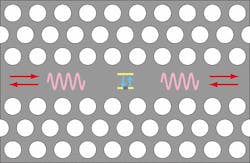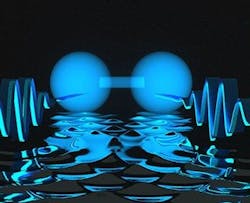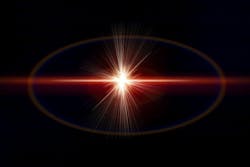
Photonics researchers continue to explore the many 'strange' properties of light such as its particle-wave duality, its ability to be slowed and manipulated within photonic crystals or certain optical fibers, the relativity theories that rely upon the speed of light being a constant value, and the process of entangling photons for quantum communications.
But a new phenomenon first theorized in 2007 is indeed very unusual: just like atoms group together into myriad molecular configurations, photons can also bunch together and create a 'photonic molecule' that just may end up having practical applications that can only be imagined. The first two-photon systems were demonstrated in 2007 by Stanford researcher Shanhui Fan and colleagues who demonstrated dual-photon transport in a waveguide material per the figure below (Image credit: Stanford University):The MIT/Harvard team is also looking to create repulsive interactions between photons that could result in ordered "crystalline" photon molecules, a state of light that is indeed fascinating to ponder.
For a much more detailed explanation of two-photon molecules and potential applications, there is a very detailed blog at https://blogs.scientificamerican.com/guest-blog/and-let-there-be-e2809cmoleculese2809d-of-light/ that is worth careful review. To date, the three-photon molecule is the largest structure of its kind. But photonics has a way of advancing rapidly, with four- and five-photon systems seeming likely (unless one of our readers wants to explain whether or not there is a fundamental limit to how many photons you can bunch together in a 'molecular' structure).
About the Author

Gail Overton
Senior Editor (2004-2020)
Gail has more than 30 years of engineering, marketing, product management, and editorial experience in the photonics and optical communications industry. Before joining the staff at Laser Focus World in 2004, she held many product management and product marketing roles in the fiber-optics industry, most notably at Hughes (El Segundo, CA), GTE Labs (Waltham, MA), Corning (Corning, NY), Photon Kinetics (Beaverton, OR), and Newport Corporation (Irvine, CA). During her marketing career, Gail published articles in WDM Solutions and Sensors magazine and traveled internationally to conduct product and sales training. Gail received her BS degree in physics, with an emphasis in optics, from San Diego State University in San Diego, CA in May 1986.


